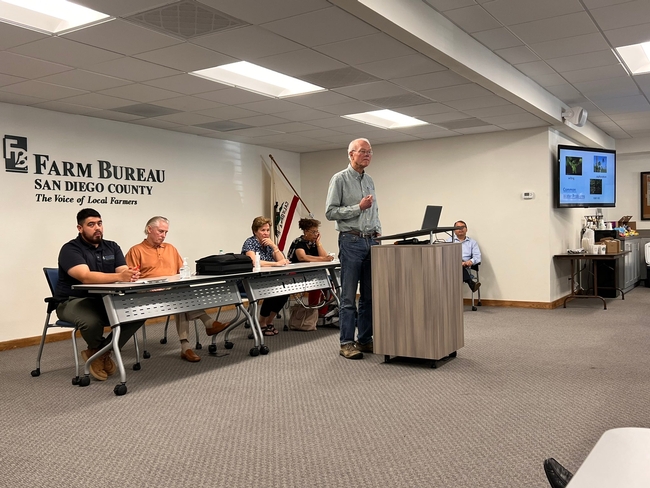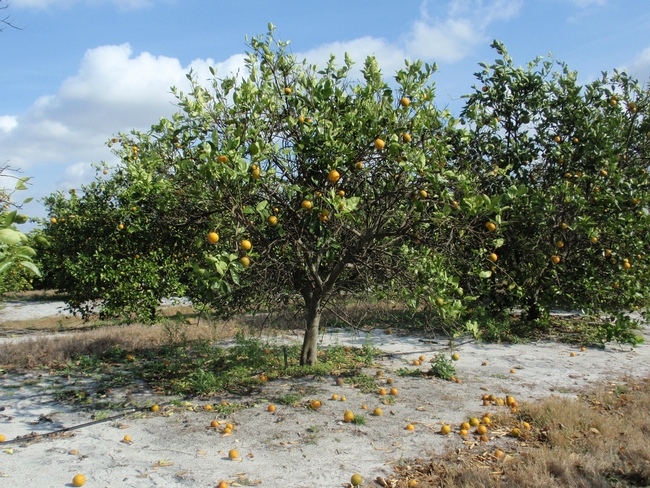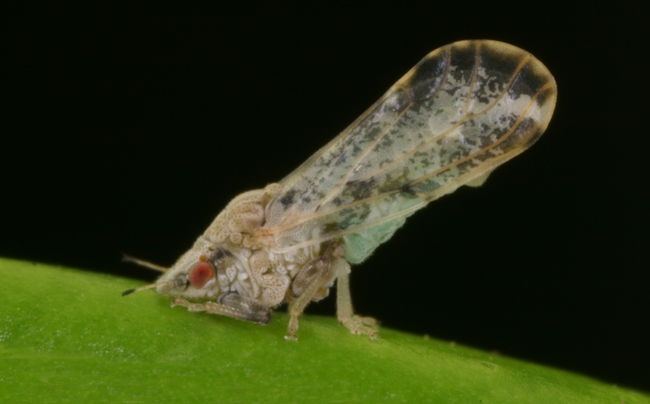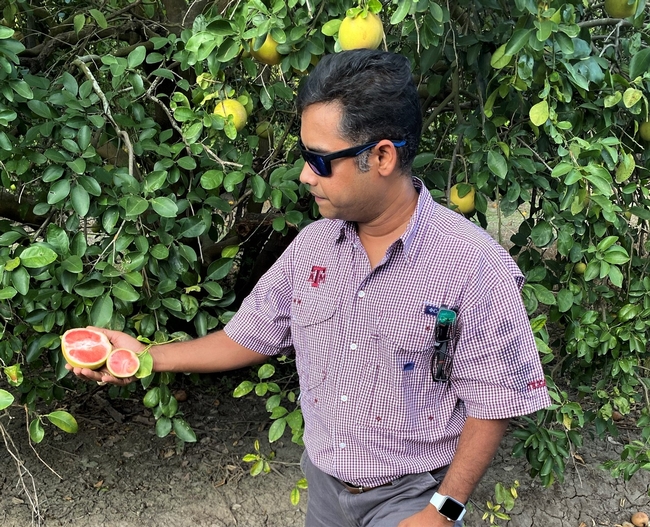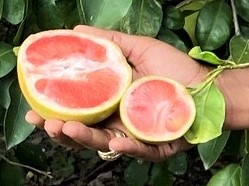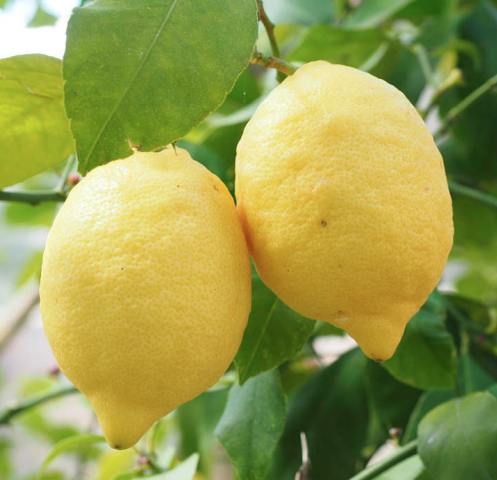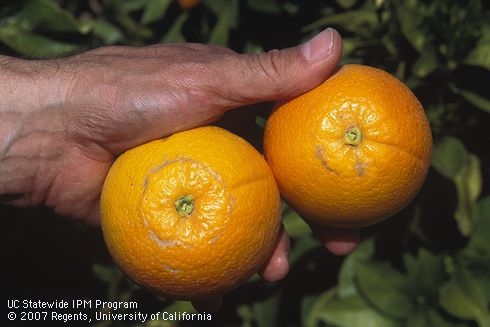Posts Tagged: Ben Faber
San Diego avocado growers look to Cooperative Extension experts to manage water costs
San Diego County used to be home to nearly 25,000 acres of avocado trees but today there are about 14,000. The drastic decrease is largely due to rising costs associated with avocado production, namely the cost of water.
On September 28, avocado growers gathered at the San Diego County Farm Bureau offices for an Avocado Irrigation Workshop facilitated by Ali Montazar, University of California Cooperative Extension irrigation and water management advisor for Imperial, Riverside and San Diego counties.
“All of our information being developed right now is focused on [irrigation] efficiency. Growers want to know how much water they need and what tools they should use to be more efficient,” explained Montazar.
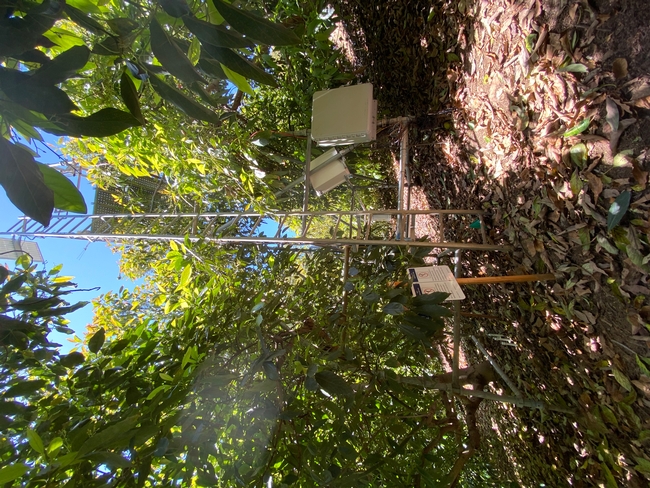
“The sophisticated research in avocado irrigation that Dr. Ali Montazar is conducting is the first of its kind that the University of California has carried out specifically in avocados. His presentation allowed us attendees the opportunity to see and learn about the technology he is employing – from soil moisture sensors to the California Irrigation Management Information System level equipped station.”
Burr is hopeful that Montazar's research will help avocado growers accurately determine the evapotranspiration in an avocado grove or water use specific to avocados, critical parts of how growers select tools to determine irrigation runtimes.
“His presentation that showed his research finding of the avocado Kc (crop coefficient), while very early into his project, was really interesting. It indicates the possibility that we may need to vary the Kc for different times in the growing season, but he is just beginning a two-to-three-year project that will hopefully deliver solid data on what the Kc for avocados is,” said Burr.
Colorado River uncertainty looms
San Diego's avocado production is primarily managed by small farms. According to Montazar, this adds a level of complexity to water management because there is a greater emphasis on irrigation tools and strategies being user-friendly and cost-efficient.
“We don't know the future,” said Montazar. “But we need to be prepared for all consequences. The Colorado River is experiencing a significant water shortage, and this could impact the water supply source for San Diego County from the Imperial Irrigation District Transfer in the future. It is wise to consider enhancing irrigation efficiency as the most viable tool to manage limited water supplies in Southern California.”
Water has always been an issue. In the 1970s, California's water program paved a way for an additional 98,000 acres of agricultural land.
According to a 1970 study analyzing the cost of avocado production in San Diego County, water costs “averaged 3½ acre feet per acre at $60 an acre foot,” which came with the assumption that water costs would remain relatively low and affordable for a long time.
Unfortunately, that is no longer the case. The county of San Diego gets the majority of its water from the Colorado River, which is concerning given five-year projections of the river reaching critically low reservoir levels by 2027.
In fact, beginning in 2023, the San Diego County Water Authority will be raising the rates for water, prompting growers to invest in more efficient irrigation practices (Table 1).
Table 1. Cost for untreated and treated water in San Diego County in 2022 and 2023.
NOTE: An acre-foot is about 325,900 gallons of water.
Training growers on irrigation a top priority
There are no loopholes or short cuts when it comes to irrigation because irrigation is the key to tree health. Ben Faber, Cooperative Extension subtropical crops advisor for Ventura and Santa Barbara counties, points out that tree health is how growers stay in business.
“You can mess up your fertilization program, and you can mess up your pesticide program, but if you mess up your irrigation program, you're out of business,” he said.
According to Faber, efficient irrigation requires a strong grasp on salt management.
“We import water that has a lot of salt in it. So, you've got to figure out how to put the right amount of water on the root zone without causing root health problems,” said Faber.
This process requires meticulous care, as anything that gets below the root zone can cause groundwater contamination – something growers do not want to be responsible for.
While the latest irrigation technology, such as smart controllers, could help growers, Faber said that training and educating farm managers should be the priority.
As Faber puts it, managing irrigation should be “like brushing your teeth” – something that growers do naturally and competently. Many growers are over-irrigating or wasting time trying to resuscitate dying trees. It's important to learn the needs of the tree and, in some cases, it might be best to stop watering all together.
The first step to water efficiency is acquiring knowledge and identifying needs. Because an over-irrigated tree looks just like an under-irrigated tree, it's crucial that growers learn to recognize the difference and plan accordingly.
This is where Cooperative Extension advisors and researchers come in. Opportunities like the Avocado Irrigation Workshop are ideal for growers looking for answers or support.
For more information and to learn about future workshops in San Diego County, visit https://cesandiego.ucanr.edu/.
Citrus threat target of $7 million multistate research project
UC ANR part of team led by Texas A&M AgriLife combating huanglongbing disease
Citrus greening, or huanglongbing disease (HLB), is the most devastating disease for orange and grapefruit trees in the U.S. Prevention and treatment methods have proven elusive, and a definitive cure does not exist.
Since HLB was detected in Florida in 2005, Florida's citrus production has fallen by 80%. Although there have been no HLB positive trees detected in commercial groves in California, more than 2,700 HLB positive trees have been detected on residential properties in the greater Los Angeles region.
“It is likely only a matter of time when the disease will spread to commercial fields, so our strategy in California is to try to eradicate the insect vector of the disease, Asian citrus psyllid,” said Greg Douhan, University of California Cooperative Extension citrus advisor for Tulare, Fresno and Madera counties.
Now, a public-private collaborative effort across Texas, California, Florida and Indiana will draw on prior successes in research and innovation to advance new, environmentally friendly and commercially viable control strategies for huanglongbing.
Led by scientists from Texas A&M AgriLife Research, the team includes three UC Agriculture and Natural Resources experts: Douhan; Sonia Rios, UCCE subtropical horticulture advisor for Riverside and San Diego counties; and Ben Faber, UCCE advisor for Ventura, Santa Barbara and San Luis Obispo counties.
$7 million USDA project
The $7 million, four-year AgriLife Research project is part of an $11 million suite of grants from the U.S. Department of Agriculture National Institute of Food and Agriculture, NIFA, to combat HLB. The coordinated agricultural project is also a NIFA Center of Excellence.
“Through multistate, interdisciplinary collaborations among universities, regulatory affairs consultants, state and federal agencies, and the citrus industry, we will pursue advanced testing and commercialization of promising therapies and extend outcomes to stakeholders,” said lead investigator Kranthi Mandadi, an AgriLife Research scientist at Weslaco and associate professor in the Department of Plant Pathology and Microbiology at the Texas A&M College of Agriculture and Life Sciences.
The UC ANR members of this collaboration will be responsible for sharing findings from the research with local citrus growers across Southern California, the desert region, the coastal region and the San Joaquin Valley.
“In addition to the ground-breaking research that will be taking place, this project will also help us continue to generate awareness and outreach and share the advancements taking place in the research that is currently being done to help protect California's citrus industry,” said Rios, the project's lead principal investigator in California.
Other institutions on the team include Texas A&M University-Kingsville Citrus Center, University of Florida, Southern Gardens Citrus, Purdue University and USDA Agricultural Research Service.
“This collaboration is an inspiring example of how research, industry, extension and outreach can create solutions that benefit everyone,” said Patrick J. Stover, vice chancellor of Texas A&M AgriLife, dean of the Texas A&M College of Agriculture and Life Sciences and director of Texas A&M AgriLife Research.
HLB solutions must overcome known challenges
An effective HLB treatment must avoid numerous pitfalls, Mandadi explained.
One major problem is getting a treatment to the infected inner parts of the tree. The disease-causing bacteria only infect a network of cells called the phloem, which distributes nutrients throughout a tree. Starved of nutrients, infected trees bear low-quality fruits and have shortened lifespans.
Treatments must reach the phloem to kill the bacteria. So, spraying treatments on leaves has little chance of success because citrus leaves' waxy coating usually prevents the treatments from penetrating.
Second, while the bacteria thrive in phloem, they do not grow in a petri dish. Until recently, scientists wishing to test treatments could only do so in living trees, in a slow and laborious process.
Third, orange and grapefruit trees are quite susceptible to the disease-causing bacteria and do not build immunity on their own. Strict quarantines are in place. Treatments must be tested in groves that are already infected.
Two types of potential HLB therapies will be tested using novel technologies
The teams will be working to advance two main types of treatment, employing technologies they've developed in the past to overcome the problems mentioned above.
First, a few years ago, Mandadi and his colleagues discovered a way to propagate the HLB-causing bacteria in the lab. This method involves growing the bacteria in tiny, root-like structures developed from infected trees. The team will use this so-called “hairy roots” method to screen treatments much faster than would be possible in citrus trees.

“Even though a particular peptide may have efficacy in the lab, we won't know if it will be expressed in sufficient levels in a tree and for enough time to kill the bacteria,” Mandadi said. “Viruses are smart, and sometimes they throw the peptide out. Field trials are crucial.”
The second type of treatment to undergo testing is synthetic or naturally occurring small molecules that may kill HLB-causing bacteria. Again, Mandadi's team will screen the molecules in hairy roots. A multistate team will further test the efficacy of the most promising molecules by injecting them into trunks of infected trees in the field.
A feasible HLB treatment is effective and profitable
Another hurdle to overcome is ensuring that growers and consumers accept the products the team develops.
“We have to convince producers that the use of therapies is profitable and consumers that the fruit from treated trees would be safe to eat,” Mandadi said.
Therefore, a multistate economics and marketing team will conduct studies to determine the extent of economic benefits to citrus growers. In addition, a multistate extension and outreach team will use diverse outlets to disseminate project information to stakeholders. This team will also survey growers to gauge how likely they are to try the treatments.
“The research team will be informed by those surveys,” Mandadi said. “We will also engage a project advisory board of representatives from academia, universities, state and federal agencies, industry, and growers. While we are doing the science, the advisory board will provide guidance on both the technical and practical aspects of the project.”
Project team members:
—Kranthi Mandadi, Texas A&M AgriLife Research.
—Mike Irey, Southern Gardens Citrus, Florida.
—Choaa El-Mohtar, University of Florida Institute of Food and Agricultural Sciences, Citrus Research and Education Center.
—Ray Yokomi, USDA-Agricultural Research Service, Parlier, California.
—Ute Albrecht, University of Florida IFAS Southwest Florida Research and Education Center.
—Veronica Ancona, Texas A&M University-Kingsville Citrus Center.
—Freddy Ibanez-Carrasco, Texas A&M AgriLife Research, Department of Entomology, Weslaco.
—Sonia Irigoyen, AgriLife Research, Texas A&M AgriLife Research and Extension Center at Weslaco.
—Ariel Singerman, University of Florida IFAS Citrus Research and Education Center.
—Jinha Jung, Purdue University, Indiana.
—Juan Enciso, Texas A&M AgriLife Research, Department of Biological and Agricultural Engineering, Weslaco.
—Samuel Zapata, Texas A&M AgriLife Extension, Department of Agricultural Economics, Weslaco.
—Olufemi Alabi, Texas A&M AgriLife Extension, Department of Plant Pathology and Microbiology, Weslaco.
—Sonia Rios, University of California Cooperative Extension, Riverside and San Diego counties.
—Ben Faber, University of California Cooperative Extension, Ventura, Santa Barbara and San Luis Obispo counties.
—Greg Douhan, University of California Cooperative Extension, Tulare, Fresno and Madera counties.
No need to amend soil when planting new trees or perennials
Gardeners who follow conventional wisdom and nursery recommendations to mix organic amendments into the soil when planting new trees or perennials in their landscapes are making a mistake, according to UC Cooperative Extension environmental horticulture experts.
“This is one of the garden myths that I'm trying to dispel,” said Jim Downer, UCCE environmental horticulture advisor in Ventura County. “We recommend residents not amend the soil when they are planting based on outcomes we have observed in research.”
Downer and Ben Faber, UCCE advisor for water, soils and subtropical crops in Ventura County, summarized this and other information about the use of organic amendments in home landscapes in a six-page publication now available for free download from the UC Agriculture and Natural Resources catalog at https://anrcatalog.ucanr.edu/Details.aspx?itemNo=8711.
The publication says research has not shown that adding amendments to planting holes for perennial plants provides a significant advantage compared to using native backfill.
With perennial plants, the roots do not stay in the planting hole for long, so amendments would only be effective for a short time. The practice of amending the soil further harms the plant by creating an interface where the soil in the planting hole is different from the native soil.
“When that happens, roots and water don't move as well through the soil,” he said.
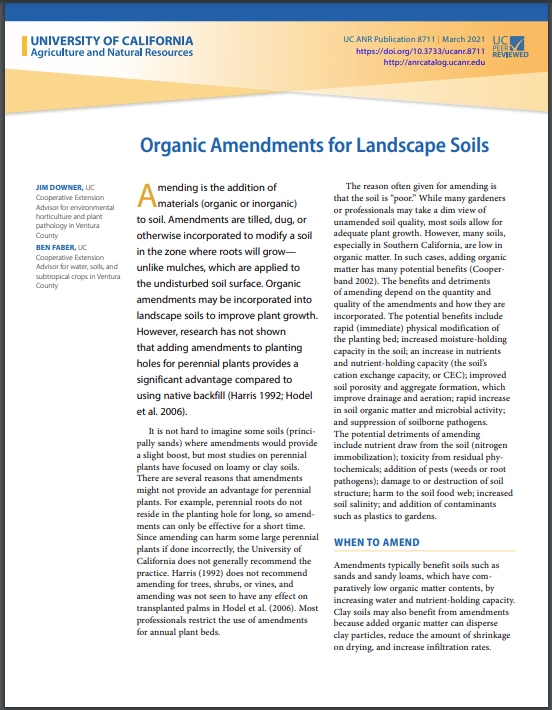
While there are few reasons to mix organic amendments into the soil, Downer said mulching the soil surface with uncomposted organic matter is almost always beneficial.
“If your goal is to get organic matter into the soil, we recommended topping the soil with fresh, undecomposed wood chips. It will give you microbial stimulation and suppress disease. Arthropods will slowly grab pieces of the mulch and incorporate it into the soil at a gentle rate,” he said.
The publication also provides information about various common organic amendments – such as coconut fiber, coffee grounds, horse manure, peat moss and green waste compost – with details about each product's benefits and detriments.
UC ANR study outlines costs and returns of producing lemons in Southern California
A new study on the costs and returns of establishing and producing lemons in Ventura County has been released by UC Cooperative Extension in Southern California and UC Agricultural Issues Center, both part of UC Agriculture and Natural Resources.
“Coastal agriculture is always in transition and as strawberries and vegetables become less profitable due to markets and labor availability, lemons have returned as a potentially profitable alternative to those crops,” saidBen Faber, UC Cooperative Extension farm advisor for Ventura County and coauthor of the study.
California lemon acreage was at roughly 47,000 acres in 2018-19, of which Ventura County accounts for 31%, according to the 2019 Ventura County Crop Report. Ventura County was growing lemons on 14,407 acres in 2019.
“The profitability of lemon production depends on the price of land,” said Etaferahu Takele, UC Cooperative Extension farm management advisor for Southern California, another coauthor of the study. “If the price of land continues in its current trend, it could be prohibitive for new entrants to make a profit and limit further expansion of lemon production in the county.”
Their cost analysis describes production operations for Eureka lemons on macrophylla rootstock, which are planted at 155 trees per acre with an expected life span of 40 years.
The study includes a detailed summary of costs and returns and a profitability analysis of gross margin, economic profit and a break-even ranging analysis table, which shows profits over a range of prices and yields.
Input and reviews were provided by Ventura County farm advisor and grower cooperators. The authors describe the assumptions used to identify current costs for lemon establishment and production, material inputs, cash and non-cash overhead.
The new study, “2020 - Sample Costs to Establish and Produce Eureka Lemons in Ventura County,” can be downloaded for free from the UC Davis Department of Agricultural and Resource Economics website at http://coststudies.ucdavis.edu and the UCCE Riverside County Farm Management website at https://ucanr.edu/sites/Farm_Management/files/338947.pdf. Sample cost of production studies for many other commodities are also available on the websites.
For additional information or an explanation of the calculations used in the studies, refer to the section of the report titled “Assumptions” or contact Takele at (951) 683-6491 Ext. 243 ettakele@ucanr.edu or Donald Stewart at the UC Agricultural Issues Center at (530) 752-4651, destewart@ucdavis.edu.
For information about production of lemons in Ventura County, contact Faber at bafaber@ucanr.edu.
UC agriculture experts offer a webinar series with continuing education credit
Continuing education credits required by the California Department of Pesticide Regulation will now be available from UC Cooperative Extension by participating in live webinars.
“Everybody is busy,” said Beth Grafton-Cardwell, UCCE citrus entomology specialist. “It's hard for people to get to meetings. Now, they can get some of the hours they need for updating their professional licenses from home or work, or even on their smartphones.”
Live webinars allow experts to talk about timely issues, such as new pest outbreaks, and give participants the option to ask questions via chat and get immediate answers from presenters.
The first webinar is from 3 to 4 p.m. Oct. 17 and will focus on citrus thrips, a perennial pest in citrus production that can vary greatly from year to year. Grafton-Cardwell will discuss biology, biological control, temperature effects, damage, monitoring, chemical control and resistance.
Participants must register in advance on the UC Ag Experts Talk website and connect to the webinar from beginning to end in order to receive continuing education credit. The course will be held on Zoom, communications software that enables video conferencing. Attendees will link into the meeting with audio and video online via computer or smartphone. Details for connecting will be emailed following online registration.
The continuing education sessions will be offered each month by various UC Cooperative Extension experts. On Nov. 14, Ben Faber, UCCE advisor in Ventura County, will discuss avocado diseases. Future class dates and topics will be posted on the UC Ag Experts Talk website.
Professional pest control advisers must complete 40 hours of continuing education every two years; qualified applicator certification and qualified applicators license renewal requires 20 hours every two years, according to the California Department of Pesticide Regulation.
All the webinars will be recorded and the sessions posted on the web, however, watching the recording will be for informational purposes only and not eligible for continuing education credit.

